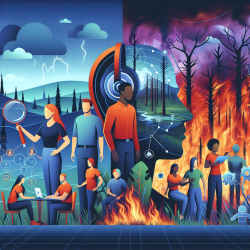Introduction
The devastating wildfire in Fort McMurray, Alberta, Canada, in May 2016, known as "The Beast," resulted in the evacuation of 88,000 residents and the destruction of 10% of the homes. This disaster had profound impacts on the community, particularly on the mental health of youth. A study conducted 18 months after the wildfire surveyed 3,070 students in Grades 7-12 to assess the long-term psychological effects. The findings are crucial for practitioners aiming to improve their skills in supporting youth affected by disasters.
Key Findings
The study revealed alarming statistics: 37% of students met the criteria for probable PTSD, 31% for probable depression, and 27% for probable anxiety. Moreover, 46% of the students met criteria for one or more probable diagnoses of PTSD, depression, anxiety, or substance use disorder. These findings underscore the significant mental health challenges faced by youth post-disaster.
Implications for Practitioners
Practitioners can draw several insights from this study to enhance their practice:
- Focus on Resilience: The study highlights the protective role of resilience in mitigating the negative effects of disasters on mental health. Practitioners should incorporate resilience-building strategies into their interventions, emphasizing skills such as problem-solving, resourcefulness, and community support.
- Comprehensive Support: Given the widespread impact of the wildfire, both directly and indirectly affected students exhibited significant mental health symptoms. This suggests the need for a community-wide approach to mental health support, rather than focusing solely on those directly impacted.
- Long-term Interventions: The persistence of mental health issues 18 months post-disaster indicates the necessity for long-term support programs. Practitioners should advocate for sustained mental health resources and interventions in schools and communities affected by disasters.
Encouraging Further Research
The study provides a foundation for further research into the mental health impacts of disasters on youth. Practitioners are encouraged to engage in research initiatives that explore effective interventions and resilience-building programs. Collaboration with educational institutions and mental health organizations can facilitate the development of evidence-based practices that address the unique needs of disaster-affected youth.
Conclusion
The findings from the Fort McMurray wildfire study emphasize the critical need for targeted mental health interventions and resilience-building strategies for youth. By integrating these insights into practice, practitioners can contribute to improved mental health outcomes for children and adolescents affected by disasters.
To read the original research paper, please follow this link: Significant PTSD and Other Mental Health Effects Present 18 Months After the Fort McMurray Wildfire: Findings From 3,070 Grades 7–12 Students.










